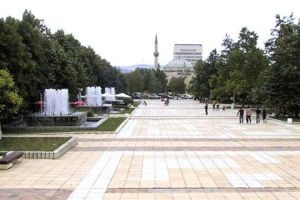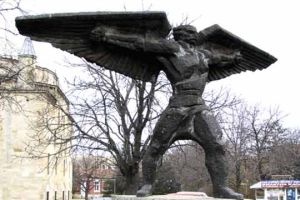Information about Razgrad
Razgrad PropertiesThe town of Razgrad has a population of 39 036 inhabitants. It is about 200 m above sea-level and is situated on the Loudogorie plateau. The town is considered the capital of the Loudogorie, on either bank of the Beli Lom River. Razgrad is 375 km north-east of Sofia, 66 km south-east of Rousse, 49 km north-west of Shoumen, 36 km north of Turgovishte, 36 km north-east of Popovo and 108 km south-west of Silistra.
History: Razgrad is the successor of the Roman settlement called Abritus (its ruins are situated near the town), the latter being established at the place of a Thracian settlement with an unknown name. The medieval Bulgarian settlement called Hrazgrad (Hrisgrad) sprang up upon the remains of the ruins of the Byzantine town already destroyed in the invasions.
In 1388 it fell under Turkish reign. Since 1573 on the town gradually grew into a craft centre. People reared silkworms. There was a trading colony from Dubrovnic dating back to 16th century.
It developed as a typical Oriental town. Bulgarians from the nearby villages gradually settled there and thus changed the ethnical pattern. In 1860 the first school opened its doors. The first Bulgarian poetess Stanka Nikolitsa Spaso-Elenina worked as a teacher in the Revival town of Razgrad.
teacher in the Revival town of Razgrad.
On 1st March 1879 when the foundations were laid for the Mausoleum of the Russian liberators Prince Dondoukov-Korsakov was among the guests present. At that time Frank Grunanger was the town’s architect.
For the last decades Razgrad has developed as a centre of pharmaceutical industry in Bulgaria.
Landmarks: The St. Nikola Church dates back to the end of 19th century. The Clock Tower is a slender stone body in the shape of parallelepiped with a wooden superstructure with a clockwork in it. It is 26.15 m high; master Todor Tonchev from Tryavna built it in 1864 replacing an old tower from 18th century. The Museum of History is situated both in the town and in the Abritus Archaeological Reserve. The Ethnographic Complex. The house-museum of Professor Dimitur Nenov has the same address. The Stanka and Nikola Ikonomovs Revival Museum Collection. The D. Danailov Art Gallery. The Ilia Petrov Art Gallery. The bronze sculpture at the Momina Cheshma. Mausoleum of the Russian soldiers who died in the Russian-Turkish War of Liberation.
In Razgrad there is Anton Strashimirov Theatre of Drama and a College for Chemical Technologies and Biotechnologies.
Accommodation: the Razgrad Hotel. The Central Hotel. The Abritus Hotel. There are very interesting restaurants in Razgrad offering original Bulgarian specialities. Here are two of them: Bai Kiro and Sons Tavern and The Academy Restaurant.
Transport: Bus and railway. There are regular bus lines to Rousse, Popovo, Turgovishte, Shoumen, Koubrat, Is-pe-rih and other smaller settlements in the district. The bus station is located in the eastern part of the town near the river. The railway station in Razgrad is situated on the oldest railway line in the country, i.e. Rousse - Varna. It makes it part of the national railway system. There is public bus transport in the town.
History: Razgrad is the successor of the Roman settlement called Abritus (its ruins are situated near the town), the latter being established at the place of a Thracian settlement with an unknown name. The medieval Bulgarian settlement called Hrazgrad (Hrisgrad) sprang up upon the remains of the ruins of the Byzantine town already destroyed in the invasions.
In 1388 it fell under Turkish reign. Since 1573 on the town gradually grew into a craft centre. People reared silkworms. There was a trading colony from Dubrovnic dating back to 16th century.
It developed as a typical Oriental town. Bulgarians from the nearby villages gradually settled there and thus changed the ethnical pattern. In 1860 the first school opened its doors. The first Bulgarian poetess Stanka Nikolitsa Spaso-Elenina worked as a
 teacher in the Revival town of Razgrad.
teacher in the Revival town of Razgrad.On 1st March 1879 when the foundations were laid for the Mausoleum of the Russian liberators Prince Dondoukov-Korsakov was among the guests present. At that time Frank Grunanger was the town’s architect.
For the last decades Razgrad has developed as a centre of pharmaceutical industry in Bulgaria.
Landmarks: The St. Nikola Church dates back to the end of 19th century. The Clock Tower is a slender stone body in the shape of parallelepiped with a wooden superstructure with a clockwork in it. It is 26.15 m high; master Todor Tonchev from Tryavna built it in 1864 replacing an old tower from 18th century. The Museum of History is situated both in the town and in the Abritus Archaeological Reserve. The Ethnographic Complex. The house-museum of Professor Dimitur Nenov has the same address. The Stanka and Nikola Ikonomovs Revival Museum Collection. The D. Danailov Art Gallery. The Ilia Petrov Art Gallery. The bronze sculpture at the Momina Cheshma. Mausoleum of the Russian soldiers who died in the Russian-Turkish War of Liberation.
In Razgrad there is Anton Strashimirov Theatre of Drama and a College for Chemical Technologies and Biotechnologies.
Accommodation: the Razgrad Hotel. The Central Hotel. The Abritus Hotel. There are very interesting restaurants in Razgrad offering original Bulgarian specialities. Here are two of them: Bai Kiro and Sons Tavern and The Academy Restaurant.
Transport: Bus and railway. There are regular bus lines to Rousse, Popovo, Turgovishte, Shoumen, Koubrat, Is-pe-rih and other smaller settlements in the district. The bus station is located in the eastern part of the town near the river. The railway station in Razgrad is situated on the oldest railway line in the country, i.e. Rousse - Varna. It makes it part of the national railway system. There is public bus transport in the town.
Surrounding areas: The Abritus Archaeological Reserve (2 km east of Razgrad near the Penicillin factory). The Romans founded the ancient settlement in the middle of 1st century and during the reign of the Byzantine emperor Justinian (527-565) the fortress walls were fundamentally fortified. The walls surround an enclosure of 140 decares and parts of them are preserved; three towers as well as the southern and northern town gates have been partially restored. There was recovered a huge building meant for living occupying an area of 3300 square meters. In 251 the Roman emperor Decius found his death in a battle between the Romans and the Goths near Abritus. In 1971 here was discovered a big ancient golden treasure consisting of 835 coins. A rich archaeological museum is open for guests (operating as a department of the Museum of History). There is a bus line round the town.
reign of the Byzantine emperor Justinian (527-565) the fortress walls were fundamentally fortified. The walls surround an enclosure of 140 decares and parts of them are preserved; three towers as well as the southern and northern town gates have been partially restored. There was recovered a huge building meant for living occupying an area of 3300 square meters. In 251 the Roman emperor Decius found his death in a battle between the Romans and the Goths near Abritus. In 1971 here was discovered a big ancient golden treasure consisting of 835 coins. A rich archaeological museum is open for guests (operating as a department of the Museum of History). There is a bus line round the town.
Some 10 km south of the town is the Pchelina Forest-Park (Kovanluka) offering excellent opportunities for rest, sport and tourism. Numerous holiday homes, restaurants, private villas as well as the mountain hut of Pchelina with 40 beds in two-, three-, and four-bed rooms. There is regular bus line.
One of the most charming places of the Loudogorie, i.e. the Voden Nature Reserve is situated 36 km north-east of Razgrad, along the Chairdere valley. The reserve is known for its venerable deciduous woods, the stock-breeding farm for aurochs, stags of fallow deer and others, and a lot of natural and historical sights. There are good accommodation facilities and a regular bus line to Razgrad.
The Thracian Tomb near the village of Sveshtari (40 km north-east of Razgrad and 6 km north-west of Isperih) has an exclusive decoration. It was declared a cultural monument of world significance and is under the protection of UNESCO. There is a regular bus line to the village from the town of Isperih.
 reign of the Byzantine emperor Justinian (527-565) the fortress walls were fundamentally fortified. The walls surround an enclosure of 140 decares and parts of them are preserved; three towers as well as the southern and northern town gates have been partially restored. There was recovered a huge building meant for living occupying an area of 3300 square meters. In 251 the Roman emperor Decius found his death in a battle between the Romans and the Goths near Abritus. In 1971 here was discovered a big ancient golden treasure consisting of 835 coins. A rich archaeological museum is open for guests (operating as a department of the Museum of History). There is a bus line round the town.
reign of the Byzantine emperor Justinian (527-565) the fortress walls were fundamentally fortified. The walls surround an enclosure of 140 decares and parts of them are preserved; three towers as well as the southern and northern town gates have been partially restored. There was recovered a huge building meant for living occupying an area of 3300 square meters. In 251 the Roman emperor Decius found his death in a battle between the Romans and the Goths near Abritus. In 1971 here was discovered a big ancient golden treasure consisting of 835 coins. A rich archaeological museum is open for guests (operating as a department of the Museum of History). There is a bus line round the town. Some 10 km south of the town is the Pchelina Forest-Park (Kovanluka) offering excellent opportunities for rest, sport and tourism. Numerous holiday homes, restaurants, private villas as well as the mountain hut of Pchelina with 40 beds in two-, three-, and four-bed rooms. There is regular bus line.
One of the most charming places of the Loudogorie, i.e. the Voden Nature Reserve is situated 36 km north-east of Razgrad, along the Chairdere valley. The reserve is known for its venerable deciduous woods, the stock-breeding farm for aurochs, stags of fallow deer and others, and a lot of natural and historical sights. There are good accommodation facilities and a regular bus line to Razgrad.
The Thracian Tomb near the village of Sveshtari (40 km north-east of Razgrad and 6 km north-west of Isperih) has an exclusive decoration. It was declared a cultural monument of world significance and is under the protection of UNESCO. There is a regular bus line to the village from the town of Isperih.
Razgrad Properties

